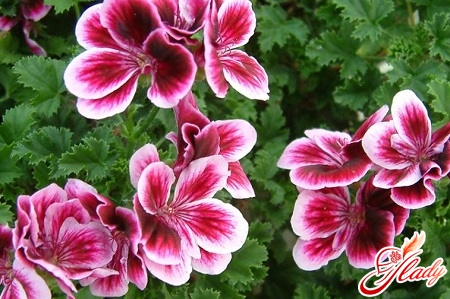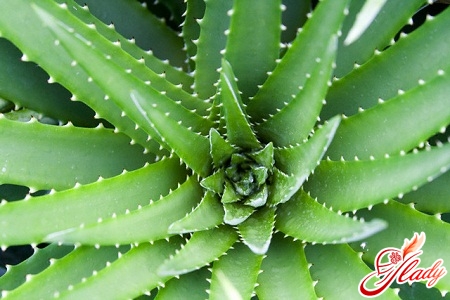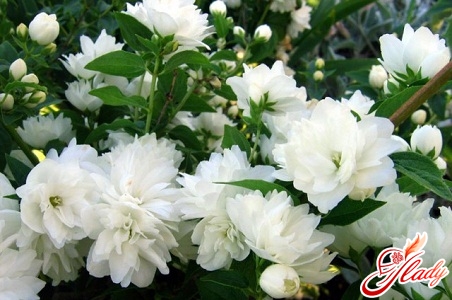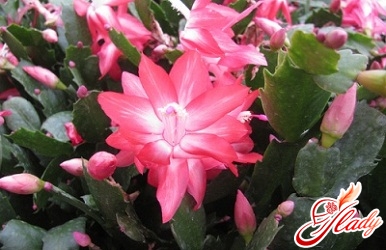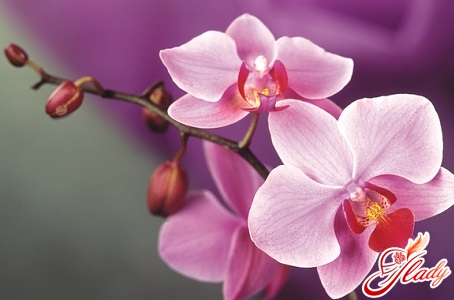 Oh, orchid! Beautiful decorative flower. Once our mothers could not have dreamed of acquiring it. Fortunately for lovers of exotic plants, the orchid has become as accessible as any other flower. It affects the number of varieties available! However, not all of them are adapted to room conditions. Hybrid species have become very popular among the available varieties. They are better suited to home maintenance, and you can regulate the rest period after the orchid has blossomed. As a rule, this process takes place in the winter. Considering the question of what to do after flowering, we will give general recommendations for popular varieties: Phalaenopsis, Cattleya, Aganasia, Wanda. Our advice will help you to ensure proper maintenance and care. And the main goal in the period after flowering is the growth of a new peduncle and the joyful expectation of fresh buds.
Oh, orchid! Beautiful decorative flower. Once our mothers could not have dreamed of acquiring it. Fortunately for lovers of exotic plants, the orchid has become as accessible as any other flower. It affects the number of varieties available! However, not all of them are adapted to room conditions. Hybrid species have become very popular among the available varieties. They are better suited to home maintenance, and you can regulate the rest period after the orchid has blossomed. As a rule, this process takes place in the winter. Considering the question of what to do after flowering, we will give general recommendations for popular varieties: Phalaenopsis, Cattleya, Aganasia, Wanda. Our advice will help you to ensure proper maintenance and care. And the main goal in the period after flowering is the growth of a new peduncle and the joyful expectation of fresh buds.
Flowering period
No doubt, the most beautiful time for orchids -this flowering. Many lovers acquire the plant during flowering. Indeed, the most beautiful unusual flowers are so fascinating that we often do not think about the question of whether or not to buy an orchid, how to take care of it and what to do next when the flowers fall off. And only later we come across the fact that this elegant flower is so capricious and it needs such delicate care that it is not always possible to preserve the pristine beauty of the plant and, moreover, to achieve its repeated flowering. With the right content, the period of flowering of orchids varies from two to six months. What influences the duration of this process and what should be the withdrawal at this time? Phalaenopsis, Wanda - varieties that refer to hybrid types of orchids, blooming at any time of the year. But in most cases everything depends on genetics, favorable conditions of maintenance and the general condition of the plant. In general, the care and maintenance of orchids are the same in all periods of plant growth, both during flowering and after, during the so-called rest period. Of course, there are special rules for caring for an orchid at all these stages, and we will dwell on them in this article.
General rules for keeping orchids for regular flowering
Lighting Most types of orchids haveon the sunny side, but it is necessary to protect the flower from direct sunlight. For example, for regular phalaenopsis blossoms, light plays an important role, but there are species adapted to less intense illumination. Considering that in winter there is very little natural light, and in summer it is, on the contrary, too much - ideal will contain an orchid on the eastern or south-eastern sides. As a rule, with this arrangement, orchids bloom every year. Temperature Range of temperature difference: day 23-28 degrees, at night not below 12-15. Some varieties of orchids for the stimulation of flowering desperately need changes in day and night temperatures of four to five degrees. If you can not provide the necessary difference in daily temperature, your orchid will bloom very rarely. As a rule, a higher daily air temperature leads to an intensive growth of the leaves, inhibiting the growth of the peduncle. In this case, it is not necessary to make the air temperature higher in winter than it usually is in the summer. On the contrary, in the winter period of rest the plant can be slightly pritenit and create a cool around it. Humidity Orchids are tropical plants, so for them the humidity of the environment is important within 50-80%. Often spray the flower and put the pot on a special tray of water, but do not forget, the roots of the plant should not touch the water. Otherwise, there will be a high probability of overmoistening and as a consequence - decay of the root system. That, in turn, leads to the death of the whole plant. Watering The main rule - do not allow the complete drying of the soil or, conversely, do not make the soil too moist. The earth in the pot must always be slightly moistened, but not wet. After flowering orchids during rest period it is recommended to reduce the frequency and volume of watering. Feeding Like any other plant, an orchid needs additional soil fertilization. It is enough to feed the flower twice a month, and it needs to be done in the intervals between flowering. Acquire fertilizers specifically designed for orchids. 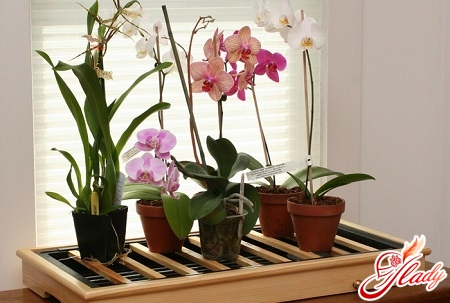
When the orchid faded away
A beautiful orchid in the apartment always deliversa lot of positive emotions and aesthetic pleasure, and the sader is the moment when the plant fades. In inexperienced growers, the question naturally arises - what to do after the orchid has faded - to cut dried flowers or leave the flower stem? Will there be any new buds and what care for the plant is required? Not knowing the features of flowering orchids, some lovers immediately cut the entire flower stem. But this decision is premature, you do not need to do this. First, make sure that the orchid has finally faded. Examine the tip of the stem and its side branches, there you can find a new growing tip. And if it is still green and not damaged, then the probability is high that the bloom has not yet ended and new additional buds may appear. This phenomenon can occur both during the main flowering, and after one to three months after the fall of all the flowers. Although it may be that this will not happen, even if the plant is provided with the necessary care. If the tip is withered, changed color, turned yellow or black, it's likely not worth waiting for new buds. What to do in this case? There are two ways: to cut off the flower stem under the base or just above the extreme "sleeping point". Many varieties of orchids have several "sleeping" buds (meristems), covered with a protective scales. In theory, all these buds as the plant grows must grow, forming a lateral flower stem, or giving a "baby". As an option, you can try to get an old bloom on the old stem. In this case, it should be cut two or three centimeters above the kidney. Here is the most unpredictable: there is no guarantee that the new buds will wake up, no matter how hard you try to look after your pet. In this condition, the cropped flower sprouts can stand for a year, and then take and wither from old age. In addition, the plant throws all its accumulated nutrients onto the maintenance of old peduncles, thereby inhibiting the development of new ones. The growth of "children" is generally an uncontrolled process in orchids. In most cases, including the popular and quite unpretentious to the indoor content of the species of orchids - Phalaenopsis, this is a hereditary phenomenon. He can give two or three offspring on each peduncle, turning the flower into a decorative thicket. Other species, on the contrary, are averse to the formation of "children", even despite the special feeding for growth and scrupulous care. Some books on the correct content of orchids provide such information: at a temperature of 16-18 ° C and with a relatively optimal humidity (in winter), a flower bud will most likely grow from the kidney, and at a temperature above 25 ° C (in summer) - a baby. Transplant in a separate pot of "children" is necessary only after growing their own roots. It is enough to wait at least three roots for four or six cm. However, if you notice that the flower stem has completely changed its color, that is now it is not green, but, for example, brown, dirty yellow, or purple, and it has dried up, no doubt - the orchid really faded. At an early stage, do not immediately remove it, the plant at this time will redistribute the nutrients stored in the dying stem, necessary for the further growth of the orchid. But the completely dried flower spoon is time to cut, and cut it off as low as possible.
Period of rest, or interflow season
Care of the plant after flowering does notdiffers from other periods. Orchid still needs sufficient irrigation, humidity, light, regular disease prevention and inspection for pests. You can slightly reduce the frequency and volume of fertilizing the plant for a period of rest, and if necessary, transplant the flower into a new pot. "Root" about the need to transplant the plant will stick out from the bottom hole of the pot roots and the rapid desiccation of the soil after irrigation. As a rule, the need for a transplant arises in two to three years. Transplant In order to pull out the orchid from the pot as gently as possible, it is necessary to water the plant beforehand and carefully remove it, without damaging the roots. Sometimes on the roots you can find moss, it should also be carefully removed, without straightening the roots themselves. Carry out a revision of the root system: cut the dry, blackened processes. Healthy roots differ in hardness and lightness. The substrate for the pot is recommended to be selected from several components. These include:
- Pine bark or cones - main drainagecomponent. The bark needs to be collected from healthy trees, only necessarily disinfect it and dry it. Large pieces should be laid on both the drainage layer and in the center of the pot. In addition, the pine bark or split scales of cones can be used for decorative purposes. As a drain, you can also use rubble, clay crocks, brick crumbs.
- Charcoal - a universal antiseptic and absorbent, perfectly supports the water balance in the soil. However, its content in the substrate should not be more than 10%, since coal accumulates salts.
- Leafy earth is the main component in the substrate. Fallen foliage during decomposition will serve as a natural food for the orchid. In addition, beech leaves, for example, promote the development of useful microflora in the soil.
- Moss-sphagnum - is necessary for looseness and conservationmoisture in the ground. To do this, cover the top layer of soil with moss pieces, scalding it first with boiling water, and then drying it. In addition, sphagnum contains a large number of substances, so necessary for plant growth. Moss should be changed every six months.
It is recommended to use clay orplastic pot. The advantage of this pot is that the clay provides excellent air exchange and moisture distribution throughout the pot. The disadvantage is a rough surface, to which the roots sometimes grow quite strongly, and to separate them later is a considerable difficulty. This problem can be solved by purchasing a clay pot covered with glaze. Ideal for beginners - plastic transparent pot, through the walls of which you can observe the state of the root system. Plastic does not accumulate salts, the soil in it dries more slowly. Another prerequisite for choosing a container for planting an orchid is a mandatory hole at the bottom of the pot, and preferably not one. When transplanting the plant, be especially careful with the roots. The flower should be immersed to the same level as in the previous container. You do not need to water after the transplantation, the best thing is to sprinkle abundantly and leave it alone in a damp, shaded place for two to three weeks. Observing all the rules of transplantation and providing delicate care, in a few months you will again see the long-awaited flowers. But it happens that a second flowering will please you only in a year. And it can happen that the plant is absolutely healthy, but it has not blossomed for a long time. Most likely, optimal conditions were not created for flowering. Revise the recommendations described above: are you all in order - light, temperature, humidity? It's not at all difficult to adapt to these rules: rearrange the orchid, purchase a special photolamp and an air humidifier. 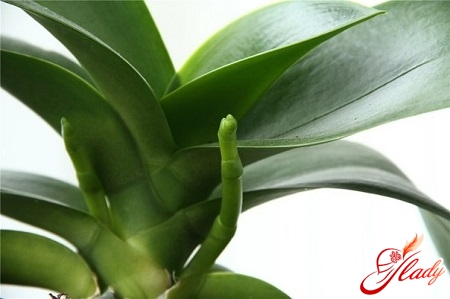
Useful tips for orchid lovers
In addition to the traditional method of growing orchids(in pots), there is one more original technique - growing on wooden bars or on a lattice of pine bark. Since orchids - plants are epiphytic, that is, they use another support for growth, then in the apartment wave one can simulate natural conditions by constructing such a site. For initial growth, the plant is neatly tied to bark or bars. In the future, the orchid itself will be attached to the developed root system. But for the successful maintenance of this plant it is necessary to provide high humidity (more than 90%) and frequent spraying of roots. Caring for the plant with this original method is necessary in a conventional way. Such precious kinds of orchids as Makodes, Gemaria, Anektokhilus grow well in glass containers (for example, small aquariums can be used). Their main value is not flowers, but beautiful leaves. They also need high humidity, but they easily adapt to the shortcomings of light. Use moss sphagnum to reserve moisture in the soil. Basically, care for deciduous orchids is no different from caring for traditional popular species. Orchid is capricious to frequent rearrangements from place to place, does not like constant reversals. It is difficult for a plant to adapt its organs so often to the surrounding conditions. Adapting to this or that position in space, the flower eventually develops its own individual feature of growth and development. Getting into new conditions, the orchid instead of growing further, expends the forces to adapt to them. If you want to see a flowering plant, the main and indispensable condition of the content will be your care, love and timely care. This plant needs a constant owner, the orchid gets used to the hands of its florist and is sensitive to any changes. Do not forget to care for the plant, an inattentive attitude will have a detrimental effect on the flower and lead to its death. Diligent, attentive, caring owners will long admire exquisite orchids and enjoy anticipation in anticipation of new colors.




